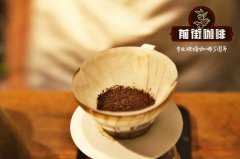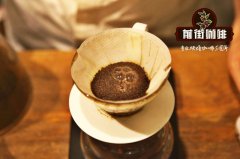Arabica Coffee Bean Variety-Iron pickup Coffee beans are dry and wet describe how the tin card tastes?

Professional coffee knowledge exchange more coffee bean information please follow the coffee workshop (Wechat official account cafe_style)
Next, I would like to introduce some improved Arabica species.
Iron pickup coffee beans (Typica)
It is the closest to the native species, widely cultivated in Central and South America, with long beans, excellent aroma and sour taste, and low yield because it is not resistant to leaf rust (the natural enemy of coffee trees) and needs more shade when it is planted. It can be harvested only once every two years.
This variety has been cultivated in Colombia until 1967, and now 80% of people in Caturra have switched to the high-yielding and sun-resistant Kaddura or mutant Colombia (Variedad Colombia)!
Bourbon (Bourbon)
This is the second species of mutation, and Tibica is the oldest coffee variety in existence.
Bourbon was transplanted from Yemen to the eastern part of Madagascar in East Africa, then to Bourbon in the Indian Ocean, and then into Brazil with the French invasion.
It is characterized by small and round beans, most of which are dense and gregarious, and the central line is S-shaped.
It is harvested once every two years, which is the same as that of iron pickup coffee beans, but the yield is not much, so it is gradually replaced by other varieties.
Kaddura (Caturra)
The bourbon mutant found in Brazil has low height, small bean grains, high yield and excellent disease resistance, but it has the same disadvantages as bourbon, which can only be harvested once every two years.
The quality is quite good, but the cost of fertilization and care is quite high. It is suitable for cultivation on the medium and high land with an altitude of 450m and an annual rainfall of 2500m and 3500 m.
It is characterized by sour taste and strong astringency.
Mondo Norwood (Mundo Nove)
The natural mating between bourbon and Sumatra has high environmental adaptability, tolerance to diseases and insect pests, high yield, but slow growth rate and large beans.
Coffee trees are relatively tall (more than 3 meters) and cannot be harvested mechanically. They were planted in the whole region of Brazil around 1950 and are now the main varieties in Brazil along with Kaddura and Kaduai.
Mondonovu's sour and bitter taste is well balanced, its taste is close to the original variety, and its name 'Mundo Nove' means a new world.
Kaduai (Catuai)
The cross between Mondonovu and Kaddura has high yield and strong environmental adaptability, and the height of the tree is different from that of Kaddura. Although it must be fully fertilized, it is resistant to diseases and insect pests, and the fruit is not easy to fall in the face of strong wind and rain.
The disadvantage is that its fruit has a harvest life of only ten years and is mainly cultivated in Colombia to Central America, which is monotonous and lacks mellow thickness compared to Mondonovo.
Marago Gippe (Maragogype)
The Tibica mutant found in Brazil has large grains and poor taste, but has a good appearance (perhaps because the particles are larger) and is favored by some markets, with higher tree height and lower yield.
Kent (Kent)
The Indian variety, with high yield and strong disease resistance, is generally considered to be a hybrid of Tibica and other varieties.
Amaret O (Amarello)
Normally, coffee fruit is red when ripe, but just like its name (Amaret Europe from modern Latin means yellow), the fruit is yellow when ripe, the tree is high, so the yield is high.
Cartimo (Catimor)
The Timo species (the mating species of Arabica and Robusta) are mated with bourbon species. Among the high-yield commercial varieties, they have the best growth length and the highest yield, with low tree height and large fruits and coffee beans.
In terms of taste, the low-real estate Cartimo is not far different from other commercial varieties, but the Katimo grown above 1200 meters above sea level is obviously inferior to Bourbon, Kaddura and Kaduai.
Mutant Columbia (Variedad Colombia)
The highly resistant varieties produced by mating between Cartimo and Kaddura are resistant to direct sunlight and can be harvested in a short period of time.
It was widely cultivated in Colombia in 1980. Generally speaking, Arabica coffee must be shaded by shading trees, but variants of Robusta origin do not need shade and can be produced and harvested throughout the year.
Through urban baking (Full-city Roasting), you can clearly distinguish the difference from Tibica. Generally, after deep baking, the sour taste becomes weaker and the bitterness increases, while the bitter taste of mutant Colombia increases sharply after the second explosion.
Important Notice :
前街咖啡 FrontStreet Coffee has moved to new addredd:
FrontStreet Coffee Address: 315,Donghua East Road,GuangZhou
Tel:020 38364473
- Prev

Flavor characteristics of Iron pickup Coffee beans introduction to the story of legendary tree species classic 1952 iron pickup coffee beans
Professional coffee knowledge exchange more coffee bean information please follow the coffee workshop (Wechat official account cafe_style) Arabica coffee beans are currently the three largest coffee varieties on the market, many of the most commercially valuable boutique coffee beans are Arabica varieties after repeated breeding and variety improvement extended many varieties in order to improve disease resistance, yield, environmental adaptation
- Next

Variety Classification of Typica Tiebika Coffee beans is Yunnan Ironhide Card a classic 1952 tin card?
Professional coffee knowledge exchange more coffee bean information please follow the coffee workshop (Wechat official account cafe_style) La vaiedad Typica iron card coffee beans A la variedad typica podra definirse como la madre de todas las variedades, ya que a partir de ella se han desarrollado, por mutacin nat
Related
- Detailed explanation of Jadeite planting Land in Panamanian Jadeite Manor introduction to the grading system of Jadeite competitive bidding, Red bid, Green bid and Rose Summer
- Story of Coffee planting in Brenka region of Costa Rica Stonehenge Manor anaerobic heavy honey treatment of flavor mouth
- What's on the barrel of Blue Mountain Coffee beans?
- Can American coffee also pull flowers? How to use hot American style to pull out a good-looking pattern?
- Can you make a cold extract with coffee beans? What is the right proportion for cold-extracted coffee formula?
- Indonesian PWN Gold Mandrine Coffee Origin Features Flavor How to Chong? Mandolin coffee is American.
- A brief introduction to the flavor characteristics of Brazilian yellow bourbon coffee beans
- What is the effect of different water quality on the flavor of cold-extracted coffee? What kind of water is best for brewing coffee?
- Why do you think of Rose Summer whenever you mention Panamanian coffee?
- Introduction to the characteristics of authentic blue mountain coffee bean producing areas? What is the CIB Coffee Authority in Jamaica?

